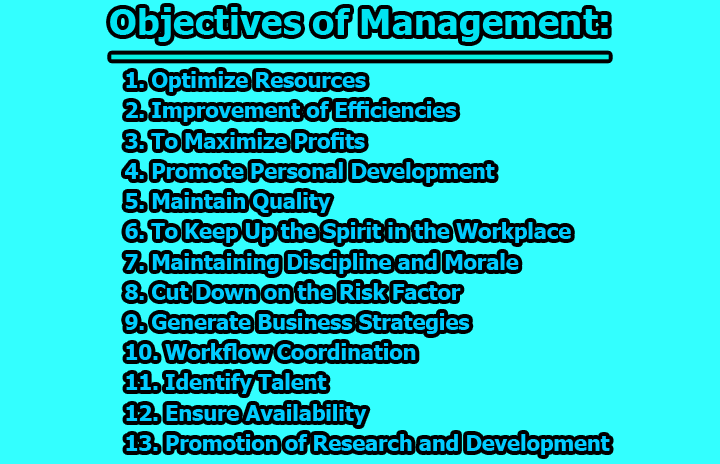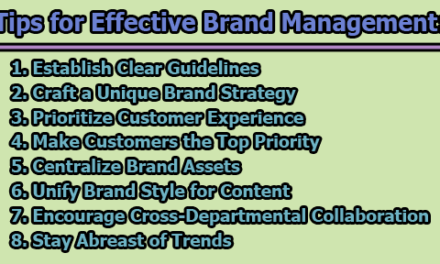Objectives of Management:
In the intricate realm of organizational management, a fundamental principle guides the actions and decisions of management teams—the pursuit of specific objectives. Management, as both an art and a science, operates within a structured framework of goals that drive its functions. These objectives serve as beacons, steering the organization toward success, efficiency, and growth. Here, we will delve into the multifaceted objectives of management, elaborating on their significance, impact, and the strategies employed to achieve them.
1. Optimize Resources: Optimizing resources stands as a cornerstone objective in management. Resources, whether tangible like finances and materials or intangible like human capital and time, are finite assets. The management’s responsibility is to extract the maximum value from these resources to achieve the desired outcomes. This objective requires a keen focus on efficiency, effectiveness, and sustainability. Management teams engage in activities such as cost-cutting, process improvement, and technology integration to ensure that resources are utilized optimally.
By adopting techniques like lean management and Six Sigma, managers identify processes that contribute to waste, redundancy, or inefficiency. These methodologies help streamline operations, eliminate bottlenecks, and reduce unnecessary resource consumption. Through effective resource optimization, organizations not only achieve cost savings but also enhance their competitiveness by delivering higher value to customers.
2. Improvement of Efficiencies: Efficiency improvement is a continuous objective pursued by management. Efficient operations translate into enhanced productivity, reduced operational costs, and increased output. Management teams embrace various tools and methodologies to analyze processes and workflows, seeking opportunities for optimization. Techniques like process mapping, time-motion studies, and workflow analysis enable managers to identify areas of improvement and implement streamlined processes.
Furthermore, management encourages a culture of continuous improvement within the organization. This involves fostering an environment where employees are empowered to identify inefficiencies and propose solutions. Through collaboration and cross-functional teams, managers drive efficiency enhancements across departments, resulting in better resource utilization, reduced lead times, and increased overall productivity.
3. To Maximize Profits: Maximizing profits is a fundamental objective for organizations, as it ensures financial viability and sustenance. However, this objective is balanced by ethical considerations and a commitment to long-term sustainability. Management teams collaborate with various departments, including finance, marketing, and operations, to develop strategies that enhance revenue generation and optimize cost structures.
To achieve this objective, managers focus on pricing strategies, product differentiation, and market expansion. They analyze market trends, customer preferences, and competitive landscapes to identify opportunities for revenue growth. Simultaneously, managers work to identify cost-cutting measures, eliminate unnecessary expenses, and optimize resource allocation to boost profit margins. The pursuit of profit maximization also requires compliance with legal and ethical standards to maintain the organization’s reputation and social responsibility.
4. Promote Personal Development: Promoting personal development among employees is an objective that goes beyond immediate operational goals. Management recognizes that an engaged and skilled workforce contributes to overall organizational success. To achieve this objective, management teams implement various initiatives that foster continuous learning, skill enhancement, and professional growth among employees.
Training and development programs are essential components of this objective. Managers collaborate with HR departments to design workshops, seminars, and training sessions that cater to employees’ needs and career aspirations. Mentorship programs, coaching sessions, and job rotations offer opportunities for employees to learn new skills and gain diverse experiences. By investing in employees’ personal development, management not only enhances individual capabilities but also builds a loyal and motivated workforce that drives organizational excellence.
5. Maintain Quality: Maintaining consistent and high-quality products and services is a crucial objective that directly impacts customer satisfaction and brand reputation. Quality assurance is a continuous effort that involves the entire organization, from production and operations to sales and customer service. Management teams collaborate across departments to set quality standards, monitor compliance, and implement corrective measures when deviations occur.
Quality control methodologies, such as Total Quality Management (TQM) and ISO certification, guide management in establishing processes and protocols that ensure consistency and reliability. Managers implement quality assurance measures at each stage of the product or service lifecycle, from design to delivery. By meeting or exceeding customer expectations, organizations build trust, gain a competitive edge, and create a loyal customer base.
6. To Keep Up the Spirit in the Workplace: Creating a positive and motivated work environment is an objective that significantly impacts employee morale, productivity, and overall organizational culture. Management recognizes that a workforce with high morale is more likely to be engaged, innovative, and committed to achieving organizational goals. Managers play a pivotal role in fostering a positive workplace culture through effective leadership, communication, and employee engagement initiatives.
Open communication channels between management and employees are essential for maintaining a positive work environment. Regular feedback, transparent decision-making, and approachable leadership contribute to trust and job satisfaction. Additionally, recognition programs, employee wellness initiatives, and work-life balance policies demonstrate management’s commitment to employee well-being. By nurturing a positive workplace culture, management enhances job satisfaction, reduces turnover, and promotes a collaborative atmosphere that drives success.
7. Maintaining Discipline and Morale: Maintaining discipline and promoting high morale within the organization are dual objectives that contribute to a harmonious and productive work environment. Discipline ensures that employees adhere to organizational policies, codes of conduct, and ethical standards. It sets the groundwork for teamwork, consistency, and organizational structure. Management establishes clear rules and expectations, communicates them effectively, and enforces them consistently to ensure a disciplined workforce.
On the other hand, promoting high morale among employees enhances their commitment, motivation, and job satisfaction. Management teams achieve this by recognizing and rewarding exceptional performance, fostering a sense of belonging, and providing opportunities for skill development. Managers listen to employee concerns, address grievances promptly, and create avenues for open communication. By balancing discipline with a positive atmosphere, management creates a workplace where employees feel valued and motivated to contribute their best efforts.
8. Cut Down on the Risk Factor: Risk management is a strategic objective that involves anticipating and mitigating potential threats to the organization’s stability and success. Management teams engage in proactive measures to identify, assess, and manage risks that could impact the organization’s operations, finances, or reputation. Effective risk management enables organizations to navigate uncertainties and seize opportunities while minimizing potential losses.
Risk assessment involves analyzing internal and external factors that could pose threats to the organization. This includes financial risks, market volatility, regulatory changes, cybersecurity vulnerabilities, and more. Management teams develop risk mitigation strategies by implementing safeguards, contingency plans, and crisis management protocols. By anticipating risks and taking preventive actions, management safeguards the organization’s continuity and resilience.
9. Generate Business Strategies: Developing effective business strategies is a strategic objective that shapes the organization’s direction, growth, and competitiveness. Management collaborates with leaders, stakeholders, and industry experts to create comprehensive plans that guide the organization’s trajectory. Strategic planning involves setting long-term goals, identifying market opportunities, and aligning resources to achieve a competitive advantage.
Effective strategic planning requires an in-depth understanding of the industry, market trends, and customer preferences. Management teams analyze market data, conduct SWOT (Strengths, Weaknesses, Opportunities, Threats) analyses, and forecast industry shifts. By identifying unique value propositions, positioning the organization in the market, and setting measurable objectives, managers create a roadmap for sustainable growth and success.
10. Workflow Coordination: Efficient workflow coordination is a fundamental objective that ensures seamless operations and resource utilization. Management teams focus on optimizing processes, procedures, and internal structures to achieve smooth and efficient workflows. Effective workflow coordination enhances productivity, reduces errors, and accelerates project completion.
To achieve this objective, management collaborates with experts in various domains, including logistics, engineering, and production. By assessing workflows, analyzing value streams, and leveraging technology, managers identify areas for improvement. Techniques like Kaizen, Just-in-Time (JIT), and Business Process Reengineering (BPR) aid in streamlining operations and minimizing waste. By implementing efficient workflows, management maximizes resource utilization and enhances overall organizational efficiency.
11. Identify Talent: Talent identification and acquisition are strategic objectives that contribute to building a skilled and capable workforce. Management teams collaborate with HR departments and recruitment specialists to define the organization’s talent needs and attract candidates with the required skills and expertise.
The identification of talent involves assessing candidates’ qualifications, experience, and potential contributions to the organization. Through effective job descriptions, rigorous interviewing processes, and skills assessments, managers ensure that new hires align with the organization’s goals and values. Moreover, talent management extends beyond recruitment to encompass employee development and retention. By recognizing and nurturing talent within the organization, management teams create a pool of high-potential employees who can drive innovation, leadership, and organizational growth.
12. Ensure Availability: Ensuring the availability of resources, products, and services is a strategic objective that supports uninterrupted operations and customer satisfaction. Management teams anticipate demand, monitor supply chains, and implement contingency plans to prevent delays and shortages. Effective availability management involves accurate forecasting, strategic inventory management, and responsive distribution systems.
Managers collaborate with procurement teams, suppliers, and logistics experts to ensure that the organization has the necessary resources on hand. By identifying potential supply chain disruptions, diversifying suppliers, and optimizing inventory levels, management mitigates the impact of unforeseen events. This objective ensures that customers receive products and services when needed, fostering loyalty and maintaining the organization’s reputation.
13. Promotion of Research and Development: Promoting research and development (R&D) is a strategic objective that fuels innovation, growth, and competitiveness. Management recognizes that staying ahead in a rapidly evolving market requires the continuous creation of new products, services, and solutions. R&D enables organizations to adapt to changing customer preferences, technological advancements, and industry trends.
Management teams allocate resources and collaborate with experts to conduct R&D activities that lead to breakthrough innovations. They invest in research initiatives, collaborate with academic institutions, and leverage partnerships to access cutting-edge knowledge and expertise. By fostering a culture of innovation, management encourages employees to explore new ideas, experiment with novel concepts, and contribute to the organization’s growth. R&D efforts lead to the development of new revenue streams, enhanced customer experiences, and a sustainable competitive advantage.
In conclusion, the objectives of management encompass a spectrum of strategic, operational, and cultural goals that collectively drive organizational success. These objectives guide the decisions, actions, and initiatives undertaken by management teams across various levels and functions. From optimizing resources to fostering innovation and maintaining quality, each objective contributes to the organization’s overall performance and resilience.
Effective management requires a balanced approach, wherein objectives are aligned with the organization’s mission, values, and strategic vision. By continually assessing and adapting to internal and external factors, management ensures that its objectives remain relevant and impactful. Ultimately, the pursuit of these objectives not only enhances the organization’s bottom line but also shapes its identity, culture, and legacy in the competitive global landscape.

Library Lecturer at Nurul Amin Degree College










